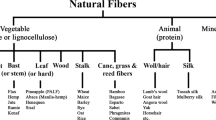Abstract
Nonwoven webs can be used as interleaves to improve the delamination resistance of fiber-reinforced composites. This paper addresses the flexural and interlaminar fracture behavior of glass fiber/epoxy composites with Spunbond polypropylene nonwoven interlayers. For this purpose, 7-layer hybrid composites were fabricated in intraply configuration using four layers of glass fabric and three interlayers of polypropylene spunbond nonwoven fabric. The effect of nonwoven fabric parameters, including areal weight densities [40, 50, 60, 70, and 90 GSM (g/m2)], and fabric orientation (longitudinal and cross direction) was investigated. The results of the three-point bending test showed that the nonwoven interlayer had a positive effect on the maximum flexural load and work of fracture. It caused an increase of approximately 163% in the maximum load of the sample, which had a nonwoven interlayer weight of 70 GSM compared with the non-hybrid glass sample. The glass fiber/epoxy composite was delaminated at lower strains than composites with polypropylene interlayer. The results showed that in hybrid samples, the presence of nonwoven interlayer led to increased Mode-II fracture toughness of composite (GIIC) by 44% and 56% in the samples which has the nonwoven interlayer weight of 90 and 50 GSM, respectively, compared to the non-hybrid glass fabric sample.













Similar content being viewed by others
Data availability
The research data are available from the corresponding author on reasonable request.
References
D. Haber, SAE Tech. Pap. (2015). https://doi.org/10.4271/2015-36-0219
J. Fan, J. Njuguna, Lightweight composite structures in transport (Elsevier, Oxford, 2016), pp.3–34
G.W. Milton, The theory of composites, 1st edn. (University of Cambridge, Cambridge, 2002)
Y. Swolfs, L. Gorbatikh, I. Verpoest, Compos. Part A Appl. Sci. Manuf. 67, 181 (2014)
P.N.B. Reis, J.A.M. Ferreira, F.V. Antunes, J.D.M. Costa, Compos. Part A Appl. Sci. Manuf. 38, 1612 (2007)
P. Davies, W.J. Cantwell, Composites 25, 869 (1994)
M.J. Folkes, S.T. Hardwick, J. Mater. Sci. 25, 2598 (1990)
J. Denk, Interlayer toughening of carbon fiber composites using nonwoven veils and multi-walled carbon nanotubes (California State University, California, 2020)
P.D.P. Jing Wang, C. Ma, G. Chen, Compos. Struct. 234, 111649 (2020)
L.V. Guangchao, N. Zhang, M. Huang, C. Shena, J. Castroc, K. Tan, X. Liu, C. Liu, Polym. Test. 69, 470 (2018)
A. Gheryani, D.C. Fleming, R.P. Reichard, J. Compos. Mater. 53, 4349 (2019)
B. Beylergil, M. Tanoğlu, E. Aktaş, J. Compos. Mater. 54, 4173 (2020)
B. Beylergil, M. Tanoğlu, E. Aktaş, Compos. Struct. 194, 21 (2018)
A. Jabbar, A. Ahmad, M. Adnan, Y. Nawab, Z. Javed, M. Irfan, Appl. Polym. Sci. 138, 50683 (2021)
P.K. Patnaik, P.T.R. Swain, S.K. Mishra, A. Purohit, S. Biswas, Mater. Today Proc. 26, 466 (2020)
M. Epstein, R.L. Shishoo, J. Appl. Polym. Sci. 57, 751 (1995)
S. Kobayashi, K.I. Suna, T. Yasuda, Adv. Compos. Mater. 21, 413 (2012)
B. Beylergil, M. Tanoğlu, E. Aktas, Steel Compos. Struct. 31, 113 (2019)
B.D. Saz-Orozco, D. Ray, W.F. Stanley, Poly Comp. 38, 2501 (2017)
M. Kuwata, P. Hogg, Compos. Part A Appl. Sci. Manuf. 42, 1551 (2011)
P.K. Patnaik, S. Biswas, Int. J. Mater. Eng. Innov. 7, 200–218 (2016)
P.K. Patnaik, S. Biswas, Adv. Polym. Technol. 37, 1764–1773 (2018)
Sharma, A. Purohit, R. Nagar, A. Patnaik, In: Proceedings of TRIBOINDIA-2018 an international conference on tribology (2018).
A. Sharma, A. Patnaik, Metal Polym. Matrix Compos. 70, 1284–1288 (2018)
P.D. Quan, U. Farooq, G. Zhao, C. Dransfeld, R. Alderliesten, Mater. Des. (2022). https://doi.org/10.1016/j.matdes.2022.110671
G. Tanchis , Reference book of textile technologies-nonwovens, ACIMIT-Italy, 1st edn (2008)
M.M.A. Allah, D.A. Hegazy, H. Alshahrani, T.A. Sebaey, M.A.A. El-baky, Fibers Polym. 24, 2877 (2023)
H. Alshahrani, T.A. Sebaey, M.M. Awd Allah, M.A. Abd El-baky, J. Compos. Mater. 57(7), 1315–1330 (2023). https://doi.org/10.1177/00219983231155013
ASTM, ASTM D7905/D7905M-14. American Society for Testing and Materials (2014)
A. Ridruejo, C. González, J. Llorca, Int. J. Solids Struct. 48, 153 (2010)
Author information
Authors and Affiliations
Corresponding author
Ethics declarations
Conflict of interest
The authors declare that there is no conflict of interest and did not receive support from any organization for the submitted work. Also, the data that support the findings of this study are available from the corresponding author, upon reasonable request.
Rights and permissions
Springer Nature or its licensor (e.g. a society or other partner) holds exclusive rights to this article under a publishing agreement with the author(s) or other rightsholder(s); author self-archiving of the accepted manuscript version of this article is solely governed by the terms of such publishing agreement and applicable law.
About this article
Cite this article
Bahmani, M., Nosraty, H., Mirdehghan, S.A. et al. Investigating the Interlaminar Fracture Toughness of Glass Fiber/Epoxy Composites Modified by Polypropylene Spunbond Nonwoven Fabric Interlayers. Fibers Polym 25, 1061–1073 (2024). https://doi.org/10.1007/s12221-023-00466-4
Received:
Revised:
Accepted:
Published:
Issue Date:
DOI: https://doi.org/10.1007/s12221-023-00466-4




